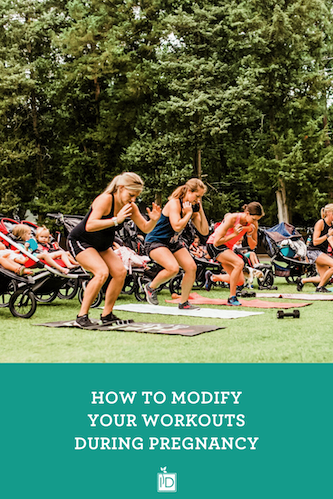You might have a number of questions on how hard to push yourself during pregnancy, which exercises are safe, and how to return to exercise after delivery.
There are so many proven benefits to exercising while pregnant including increasing energy, improving mood, and helping you sleep better. Exercise also helps reduce common symptoms that show up during pregnancy like constipation, backaches, bloating, and swelling and reduces the risk of health issues like gestational diabetes, high blood pressure, and preterm labor. All of these benefits can motivate you to work out during pregnancy, but you might have a number of questions on how hard to push yourself, what exercises might be safe, and how to return to exercise post-baby.
Exercise during pregnancy should definitely look different. You may have heard the words “listen to your body,” but what does that mean exactly? It means your body will often give you signs that you may be pushing too hard. Listen to those signs and adjust your workout so that you are able to exercise symptom free. Here are some adjustments from Pregnancy and Postpartum Athleticism to consider throughout your pregnancy to help guide you. For more detailed information check out Brianna Battles: How to Adjust Your Training During Pregnancy.
FIRST TRIMESTER
In your first trimester, the focus is not as much on modifying exercise for your core and pelvic floor as it is to modify based on your energy levels. This trimester is often accompanied by nausea and reduced energy levels, so giving yourself permission to rest when needed or to reduce the number of reps in an exercise, the amount of weight you are using, and the amount of time you are working out is very important.
SECOND TRIMESTER
In the second trimester you are hopefully gaining back some energy and with your belly starting to grow, you will need to make some adjustments in order to protect your core and pelvic floor. In this trimester, you start to distinguish the risk versus reward for exercise and movement. What this looks like is saying to yourself, “I CAN still do that, but SHOULD I do that?” This is especially true for the higher impact movements such as jumping, running, sprinting, box jumps, and jumping rope. You may also adjust exercises done in the belly down position by putting your hands on an elevated surface for planks, pushups, mountain climbers, etc. Reducing the amount of weight you use and adjusting your stance can help you to feel more comfortable. Eliminate breath holding, inverted movements, gymnastic movements, and any lifts in which your belly causes you to have to change the path of the bar. These exercises are all likely things you CAN still do, but they put a tremendous amount of pressure an already stressed core and pelvic floor. While you are working out, you should be able to hold a conversation. It is important to establish strategies now that will help you throughout the rest of your pregnancy and postpartum. Strategies include manipulating breath, load, volume, intensity, and range of motion. Breathing strategies include exhale on exertion or the hard part of the movement OR inhale before you start movement and then exhale during the entire range of motion.
THIRD TRIMESTER
You will continue the adjustments to exercise you made in the second trimester, but at this point in your pregnancy, you should prioritize rest, comfort, and strategies above all else. You will continue to decrease load, volume, intensity, and range of motion based on your symptoms. If you are experiencing symptoms (including pelvic pain or pressure, pubic symphysis, leaking, coning of the abdomen) that cannot be alleviated through the above adjustments, consider seeing a pelvic floor physical therapist who can give you a thorough assessment of your core and pelvic floor.
FOURTH TRIMESTER
The fourth trimester includes the first three months after you have a baby. This is the time to rest, relax, and take care of your healing body and your brand-new baby. This may be easier said than done, especially if you have other children needing your attention. Eating a balanced diet to fuel your body is also very important. This is a great time to start to reconnect your mind to your body. As pelvic floor physical therapist Addie Holzmann explains, “Your body goes through sudden structural, postural, and hormonal changes after birth, needing to reconfigure how it moves and stabilizes. Progressing back to fitness should start with re-establishing the brain-body connection for awareness in order to control movement. Building this foundation will allow better mechanics with higher level activities and less risk of injury and core-pelvic floor issues.” If you can, get an assessment by a pelvic floor physical therapist before returning to exercise. PTs can give you the best information about your healing and recovery that will help you return to function and exercise safely and effectively.
I hope this information is able to help you in your pregnancy and postpartum journeys. This chapter of life challenges us in ways we may have never expected. I encourage you to join a group of moms near you who can help you through it, because I can assure you from experience that motherhood is so much better together.
ABOUT ALEXA
Alexa Smith
Alexa Smith is the founder of Stroller Strong Moms, affectionately called S.L.A.M. Sweat Like a Mother. The mission of S.L.A.M. is to bring women together as moms and athletes to become the best version of themselves they can be! The fitness classes focus on function, healing, and performance of the pregnant and postpartum athlete. They have 34 affiliates throughout the US and UK, many of them near military installations. S.L.A.M. not only helps mamas stay active with their kiddos in tow, it also provides a support system for mamas to lean on each other especially during the difficult times that come along with being a military spouse. Many of the owners/instructors have education in Pregnancy and Postpartum Athleticism and use their education and training in order to safely and effectively guide mamas through exercise during their pregnancies and beyond.
CONNECT WITH ALEXA
Website | Facebook | Twitter | Instagram




